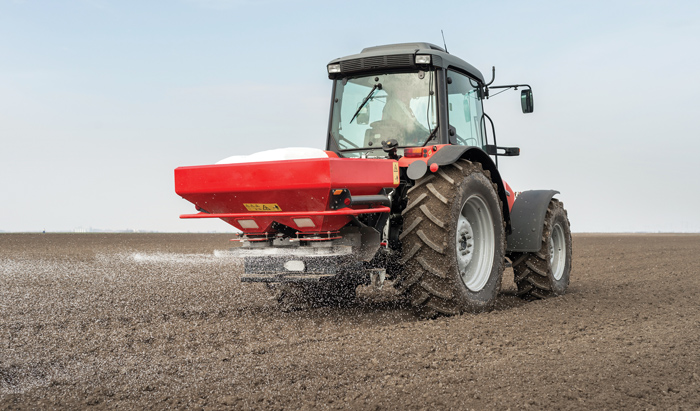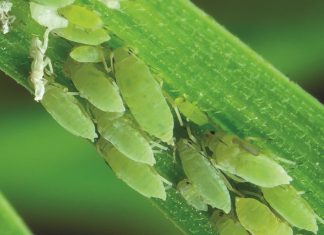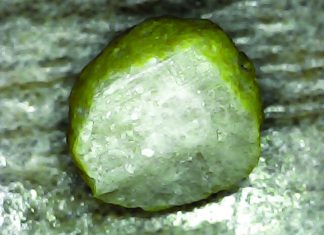
on behalf of the Depart-
ment of Agronomy, Stellenbosch University
Most regulated sources of lime and related products sold on the South African market actually have the same effect on soil pH in the long term, as long as the liming rate is corrected for calcium carbonate equivalence (CCE) before application. Some just react faster than others, according to agronomists and soil scientists at Stellenbosch University (SU) who tested most products available locally.
The research was done by an MSc student in soil science, Dawid du Toit, under the supervision of Dr Ailsa Hardie of the university’s Department of Soil Science and Prof Pieter Swanepoel of the Department of Agronomy.
Producers are aware that acidic soils lead to poor crop yields. As aluminium and other toxic metals build up in acidic soils, they negatively affect the development of plant roots, the microbial life in soils, and the availability of essential plant nutrients such as phosphate.
‘Applying class A lime to soils is probably the most effective and economical way to correct low soil pH,’ explained Du Toit.
The three main factors regarding liming materials important for producers, are the following:
- Is it effective at increasing soil pH?
- Can it be applied practically?
- What does it cost?
Most local studies about the effectiveness of lime were done between the 1980s and 2000s, before newer granulated microfine limes were launched onto the market.
‘The newer liming products claim to work better than others, stating that one could use substantially less yet still get the same results. We did the research to help producers decide which ones are indeed better, and if the added cost of some is worth it,’ Du Toit noted.
The study
Du Toit compared calcitic and dolomitic liming products mined from different South African quarries. It included three different lime forms: class A, microfine and granulated microfine.
He tested how each improved the pH levels of acidic soil within a year. He conducted controlled laboratory-based incubation tests. The liming products were mixed with three acidic topsoils with different textures: sandy, sandy loam and loamy. In this study, liming materials were applied to the soils adjusted for CCE to achieve a target pH(KCl) of 5,5 and incubated at 85% of field capacity for a year.
Microfine calcitic limes and hydrated limes increased the pH level of soils the fastest, obtaining pH levels above the target pH within 24 hours for all three soils.
‘Reaction rate is an important factor for producers, as they seek an immediate return
on their lime investment,’ Du Toit explained the relevance of this finding. However, measured over the course of a year, this difference in performance became negligible compared to the class A products. This is important as it is impractical and uneconomical to apply these microfine limes. The microfine limes only increase soil pH faster, it does not mean less material can be applied to obtain the same result.
Where a product was mined had no significant influence on the end result. After 365 days of use, only a small pH difference of around 0,45 pH units could be found between all class A liming materials on all three soils, irrespective of where these were mined.
Because of the lower atomic weight of magnesium (Mg), dolomitic limestone has a higher acid neutralisation capacity than calcitic limestone. Dolomite is less soluble than calcite and therefore reacts more slowly. However, the results from this study showed that class A calcitic and dolomitic limes tend to behave similarly over a year. This indicates that the difference between calcitic and dolomitic lime is of little importance in actual practice.
Class A limes reacted more slowly than the microfine calcitic and hydrated limes, although the pH differences between the class A and microfine materials decreased over the course of a year, with no significant difference between the microfine limes and class A limes after 365 days.
The rock type of the material also affects the reaction rate of lime. Liming materials from sedimentary origin is more porous than those from metamorphic origin and will consequently react faster. However, if the liming material meets the minimum fineness requirement stated by law, the origin of the material is of no importance.
‘These findings suggest that producers really do not have to incur higher costs by transporting lime materials from quarries some distance away from their farms,’ said Du Toit.
Chemical purity
Chemical purity had the greatest influence on how effective a product was over 365 days. It is measured in terms of the percentage CCE a product contains. The ability to neutralise acidic soils lies in a product’s CCE.
‘CCE indicates the chemical purity of a liming material,’ Du Toit explained. ‘It can vary greatly across quarries and even within a quarry, as can the proportion of calcium carbonate (CaCO3) and magnesium carbonate (MgCO3) a liming product eventually contains.’
‘It is critical to correct lime application rates by lime CCE to ensure that the required amount of CaCO3 is applied to soils,’ noted Du Toit.
Influence of particle size
The particle size of a liming material also had an influence. As mentioned earlier, the microfine products gave soils a quick pH spike, with soil pH dramatically increasing within four to seven days. ‘It is well known that finer limestone has more surface area per unit weight and can consequently react more quickly to neutralise soil acidity,’ he said.
Influence of granulating microfine lime
Although fine lime has a better reaction rate, it is impractical to spread evenly or accurately, especially in windy conditions. Granulated lime is easier to apply, because it is made from granulating microfine limestone mixed with a binding agent.
However, researchers noted that producers using granulated microfine lime could find major differences in the soil pH measurements they take. The granule treatments varied considerably between pH measurements and did not show a clear trend in increasing soil pH on any soil after 365 days of incubation. The pH measurements sometimes differed drastically within replications and between sampling dates.
This variability in pH measurements is a result of a high pH that arises in the soil in direct contact with the granule. It leads to over-limed high pH zones around the granules and under-limed low pH zones where little to no pH change occurred further from the granules. Consequently, the granules will cause pH differences within the soil. Results obtained with the granules might therefore be misleading, because some pH measurements will indicate no pH change while others will suggest satisfactory pH change.
In terms of pH correction, granulated limes also showed the poorest performance of all liming materials. The research team attributed it to the poor solubility of the granules and resultant patchiness of liming effects in the soil.
‘It seems that when microfine limes are pressed with a minor quantity of molasses during the granulating process, particles bind tightly. This makes it difficult to disperse into the soils when in contact with water. The soil matrix seems to help to hold the granules intact, which in turn influences the ability of the limes to disperse into the soil. Even after 365 days of incubation, the granules were undissolved and still intact within the soil,’ the researchers noted.
‘Microfine granules therefore do not behave like microfine lime that rapidly reacts with soil to increase pH over a short period of time. It behaves more like a course lime particle that dissolves more slowly,’ they cautioned.

The results obtained do not substantiate the claim of advertisers that molasses-granulated microfine calcitic lime is so much better at correcting soil acidity than class A limes. It does not react as quickly as powdered microfine limes, and performed poorly in comparison to class A limes.
It is very important to understand that each CaCO3 particle can neutralise two protons. That’s it. The fineness of the particle does not mean it can neutralise more protons, it just reacts more quickly. It should therefore not be applied at lower rates than the lime requirement.
‘If corrections are made for CCE before lime is applied, and the material complies with the minimum fineness requirements, all class A liming materials will likely be able to increase soil pH to levels that are adequate for crop production. The results of this controlled study illustrate the reactivity of the various liming materials under ideal soil mixing and moisture conditions. Slower reaction rates can be expected under rainfed field conditions where ideal mixing most probably will not occur,’ Dr Swanepoel noted.
The results of the present study are also currently being tested in field trials in the southern Cape and Swartland regions.
Important to remember
- In South Africa a liming material may only be sold if registered as a fertiliser and if it meets specifications required by law. Act No. 36 of 1947 (Department of Agriculture, Forestry and Fisheries, 2012) among others requires that all liming materials should consist of at least 70% CCE.
- Limestone quality is defined by the combination of its chemical and physical attributes, such as chemical purity, fineness and rock type.
- To be sold as a class A agricultural lime, at least 50% of the material should pass through a 250-μm sieve and at least 100% should pass through a 1 700-μm sieve.
- A liming material may be registered as microfine in South Africa if at least 95% of its granules pass through a 250-μm sieve and at least 80% pass through a 106-μm sieve.
SA Lime and Gypsum, Yara Fertiliser and the Winter Cereal Trust are acknowledged for funding the trials.





























